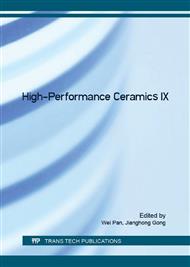p.561
p.565
p.572
p.576
p.581
p.586
p.591
p.595
p.599
Effect of Spinel Content on the Reaction of Porous Periclase-Spinel Ceramics and Cement Clinker
Abstract:
Corrosion of five porous ceramics with near apparent porosities (26%~29%) and different spinel contents by cement clinker was conducted, and the effect of the spinel content on the reaction between porous periclase-spinel ceramics and cement clinker was investigated by SEM, EDS, and FactSage® thermo-chemical software, etc. It can be found that : (1) The dissolution rate of periclase into cement clinker is slow whereas that of spinel into cement clinker is fast; (2) The more the spinel content in the porous ceramics, the higher the dissolution rate of porous ceramics into cement clinker, then the higher corrosion index; the dissolution of spinel into cement clinker changes the composition of the penetrated slag and made the viscosity increases; (3) For the specimens with similar pore size and low viscosity of penetrated liquid phase, the more the liquid content, the higher the penetration degree of liquid to specimens; the further penetration will be stopped with an increase of liquid viscosity, then the contact area between refractory and cement clinker decreases, in the result, the corrosion index decreases. When spinel contents is 0~10mol%, porous periclase-spinel ceramics possess higher penetration resistance and corrosion resistance.
Info:
Periodical:
Pages:
581-585
Citation:
Online since:
July 2016
Authors:
Price:
Сopyright:
© 2016 Trans Tech Publications Ltd. All Rights Reserved
Share:
Citation:


